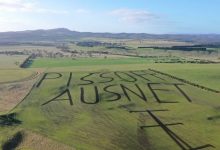The construction of major new electricity transmission lines to better link Australia’s National Electricity Market states and to accommodate increasing amounts of large-scale renewables is back in the spotlight, courtesy of an angry Victorian farmer and his plough.
The ABC reported on Monday that a Myrniong grain farmer used one of his crop paddocks to send a blunt message to local network owner, Ausnet, over its plans to run 200km of high-voltage powerlines through rural properties near Ballarat to a wind farm at Bulgana, north of Ararat.
The message – “PISS OFF AUSNET” – is a very specific one, from a specific group of frustrated and worried farmers who fear that the project will threaten their livelihoods. But it’s also a message, writ large, that should be heeded by all of the proponents of Australia’s energy market transition. And while novel in approach, its sentiment is not new.
As Ketan Joshi put it in his article on opposition to new network infrastructure in June, “it is becoming increasingly clear that even if new climate technology is cheap, efficient and even popular with politicians, it still might fall at the final hurdle of winning community support.”
And with the Australian Energy Market Operator’s final version of its Integrated System Plan last week naming the construction of major new transmission links between state grids and within specified renewable energy zones as one of its highest priorities, it’s an issue that won’t go away.
According to the ISP, the most urgent of these new links are between NSW and Victoria – particularly as the growth of rooftop solar makes the ancient and inflexible brown coal generators in Victoria difficult to manage; the Marinus link between Tasmania and Victoria; the Hume link to deliver the Snowy 2.0 to where it might be useful, and a new link, Project EnergyConnect, from South Australia to NSW.
Tasmania already fighting its own battle over transmission infrastructure required to support the Marinus Link, and to distribute the renewable energy generated by the Robbins Island and Jim’s Plain wind farms, planned for the state’s north.
As RenewEconomy has reported, the main push-back from locals has not been over the wind farms themselves – a traditional focus of NIMBY-ism in Australia and globally – but crucial new network infrastructure being built to connect them to the island state’s main grid and the Marinus Link.
The Marinus Link, in turn, is a centrepiece of state utility Hydro Tasmania’s Battery of the Nation aspirations and numerous proposed wind developments, all of which support the Tasmanian government’s recently ratcheted-up target of 200% renewables by 2040.
In this case, the locals living in the state’s Loongana Valley community had not bargained on having a 60-90 metre wide easement with 45-60 metre high transmission line towers as part of their view.
“The transmission line will divide the narrow valley, 17 kilometres from Cradle Mountain, and cause widespread damage to critical habitat for threatened species, contaminate water supplies, increase fire risk, and harm local tourism and land values,” newly formed and targeted action group SOLVE said in May.
More recently, avian experts from BirdLife Tasmania have added their own objections to the transmission project, arguing that a second electricity cable across the Bass Strait would be a “death knell” for Tasmania’s wedge-tailed eagles.
“How can you possibly approve the Marinus Link without any Environmental Impact Assessment?” BirdLife Tasmania convenor Dr Eric Woehler asked the Burnie Advocate, in a reference to the Prime Minister’s recent fast-tracking of the project.
It’s a thorny problem and one that can not be batted away. As Joshi put it, “what is happening in Tasmania is not a ‘right wing’ phenomenon. It is dangerously bipartisan… (and) the backlash won’t be limited to one worldview.”
Internationally, Germany offers a sobering cautionary tale, as it rushes to build another 1,600km of transmission lines and upgrades on a further 2,900km by 2030, according to recommendations by the four transmission grid operators.
At a German grid conference at the beginning of this year, experts warned that power grid expansion would become the German energy transition’s next big “object of hate” if it wasn’t handled very carefully.
In Australia, at least, we have the example set by the wind industry, which discovered – mostly the hard way, in Victoria – that community engagement is one of the most important cornerstones of success of any large renewables project.
As an Australian Wind Industry Forum heard in 2018, the rapid unravelling of community support for wind farms in Victoria in the first decade of the 2000s almost brought the industry undone, and resulted in five senate and parliamentary inquiries, the introduction of prohibitive planning laws, frequent public protests, lots of negative media, and the establishment of a National Wind Farm Commissioner.
That latter consequence has proved to be a major positive, though, helping to drive a much more positive and proactive dialogue between project developers and communities; so much so that a Climate Change Authority report recommended the role be extended a further three years and broadened to oversee the development of large-scale solar and battery storage in Australia.
Perhaps it should now include transmission projects, too.







